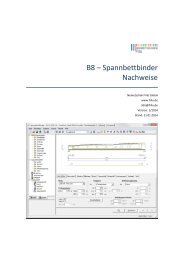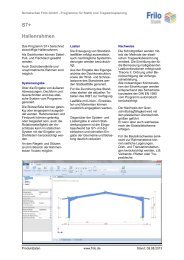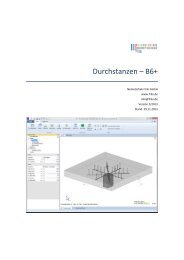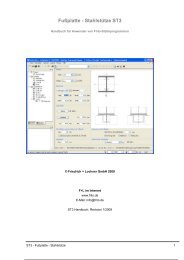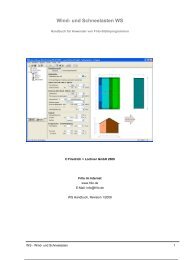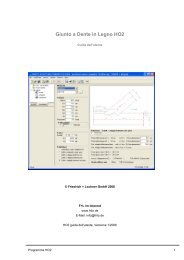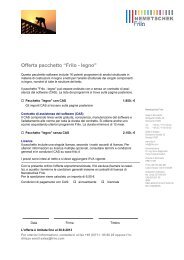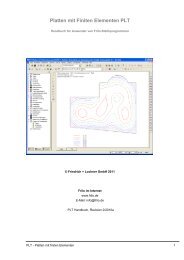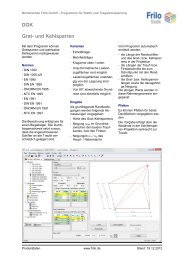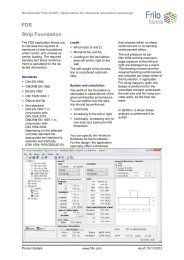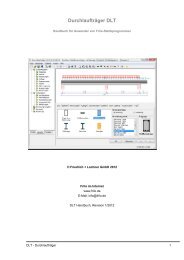ST9 Bolted Steel Connection - Frilo
ST9 Bolted Steel Connection - Frilo
ST9 Bolted Steel Connection - Frilo
Create successful ePaper yourself
Turn your PDF publications into a flip-book with our unique Google optimized e-Paper software.
Nemetschek <strong>Frilo</strong> GmbH - Applications for structural calculation and design<br />
<strong>ST9</strong><br />
<strong>Bolted</strong> <strong>Steel</strong> <strong>Connection</strong><br />
The <strong>ST9</strong> application is suitable<br />
for the design of screw connections<br />
in steel construction.<br />
The following types of connections<br />
are available:<br />
- Tensile splice with butt straps<br />
- Beam connection (shear<br />
force connection with angle<br />
brackets)<br />
- Rigid splice with butt straps<br />
- Front plate splice<br />
Standards<br />
DIN 18800<br />
DIN EN 1993<br />
ÖNORM EN 1993<br />
The connection may have almost<br />
any geometry (also beyond<br />
standard solutions such<br />
as connections flush to the<br />
ceiling etc).<br />
In addition, the application generates<br />
workshop drawings true<br />
to scale, which can be printed<br />
or transferred to the CAD sys-<br />
tem via a DFX interface.<br />
Tensile splice<br />
In a tensile splice, only tensile<br />
forces that apply in the gravity<br />
line of the screw pattern are<br />
transferred.<br />
The connection can be single-,<br />
double- or multi-shear.<br />
The user can optionally select<br />
whether the tie is a metal sheet<br />
or an I-shaped (single tie) or Ushaped<br />
(single or two ties)<br />
cross section from the F+L<br />
profile section file.<br />
Beam connection<br />
In a beam connection (shear<br />
force connection with angle<br />
brackets), only shear forces are<br />
transferred in the direction of<br />
the beam web.<br />
The permissible profile types<br />
for main and secondary beams<br />
are I-shaped profiles connected<br />
with two angle brackets with<br />
equal or unequal legs.<br />
The secondary beam can be<br />
connected with an offset to the<br />
main beam and have a notch<br />
on top on bottom or on both<br />
sides.<br />
Rigid splice with butt straps<br />
In a rigid splice with butt straps,<br />
axial forces, shear forces and<br />
bending moments can be transferred.<br />
The user must preset outer web<br />
and flange butt straps.<br />
He/she can optionally preset<br />
inner flange butt straps.<br />
I-shaped cross sections are<br />
allowed for the beam.<br />
Front plate splice<br />
EN 1993:<br />
The design of connections is<br />
based on the component model<br />
of EN 1993-1-8.<br />
The front plate can be fitted<br />
with two vertical rows of<br />
screws.<br />
Product details www.frilo.com As of: 18/09/2012
DIN 18800:<br />
In a front plate splice as defined<br />
by the DASt 1 guideline (1984),<br />
two beams of doublesymmetrical<br />
I-profiles are connected<br />
by means of welded-on<br />
front plates, either flush to the<br />
outer edges or projecting in the<br />
tension zone, and high-strength<br />
pre-tensioned screws (HV<br />
10.9). Axial forces, shear forces<br />
and bending moments can be<br />
transferred. However, the application<br />
does not allow the<br />
1<br />
German Committee for <strong>Steel</strong> Construction<br />
user to apply only tension or<br />
only compression in the beam<br />
cross section.<br />
The front plate can be fitted<br />
with two or four vertical rows of<br />
screws.<br />
Design optimization<br />
An automatic design optimization<br />
feature is available for the<br />
front plate splice and the shear<br />
force connection with angle<br />
brackets. For this feature, the<br />
geometries of typical connections<br />
are stored in a catalogue.



